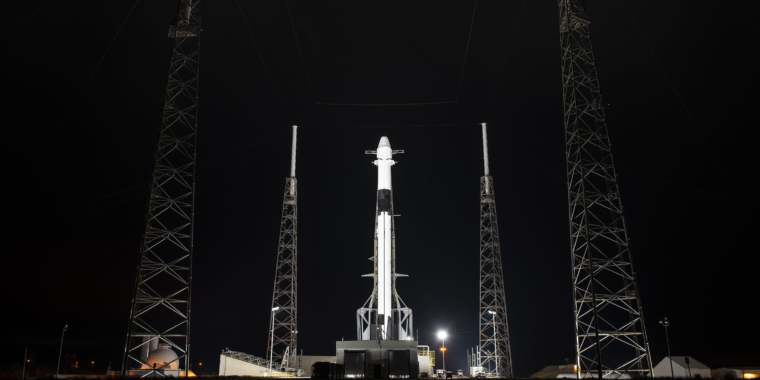
-
On Wednesday morning, the Falcon 9 rocket stands ready on the launch pad.Trevor Mahlmann for Ars
-
A new Falcon 9 rocket is ready for launch during the pre-dawn hours.SpaceX
A twice-flown Dragon spacecraft is ready to be launched on Wednesday to the International Space Station. The mission, which will ferry nearly 2.6 tons of supplies to the orbiting laboratory for NASA, will remain in orbit for about a month before returning to Earth with more than 50 science experiments.
Liftoff is scheduled for 12:51pm ET (17:51 UTC) from Space Launch Complex-40 in Florida. Surface weather conditions are fine, but there are concerns about upper-level winds reaching as high as 120 knots later today. Before launch, meteorologists will release a weather balloon to determine whether upper atmospheric conditions are acceptable for the rocket to navigate through. A back-up launch opportunity is available at 12:29pm ET on Thursday.
New rocket
SpaceX has built a new Falcon 9 rocket for this mission—hence, no soot in the launch pad photos. However, it will be flying a different profile for this space station supply mission. Typically, the newest variant of the Falcon 9 rocket has enough lift capacity to loft the Dragon spacecraft into orbit before using its remaining fuel to steer it back to a landing site on the Florida coast.
In this case, however, the Falcon 9 rocket's first stage is slated to land on the Of Course I Still Love You drone ship more than 100 miles offshore. Asked about this, SpaceX's director of Dragon mission management, Jessica Jensen, said Tuesday that the rocket's upper stage is slated to fly a "thermal demonstration" for another, unnamed customer. To put this second stage into the proper orbit for this demonstration, the first stage will need to burn longer and will not have the fuel needed to return to the coast.
Asked for more information about the second stage's six-hour coast, Jensen said she could not provide much additional detail. This suggests the mission may be demonstrating some capability to the Air Force to put classified payloads into a special orbit.
Used spacecraft
This particular Dragon spacecraft has completed two missions already, and this will be its last. The first version of the Cargo Dragon spacecraft, developed between 2006 and 2010, was qualified to fly up to three missions before being disposed.
SpaceX plans to fly one more mission with the original run of Dragons—which will be the 20th resupply mission for NASA—before transitioning into a "Cargo Dragon 2" vehicle. This newer vehicle will have 30% more cargo volume, twice as many powered lockers for storage, and the capability for autonomous docking. Additionally, the vehicle will be capable of up to five missions before retirement. It should debut in the third quarter of 2020, Jensen said.
Listing image by SpaceX
https://news.google.com/__i/rss/rd/articles/CBMicGh0dHBzOi8vYXJzdGVjaG5pY2EuY29tL3NjaWVuY2UvMjAxOS8xMi9zcGFjZXgtc2V0LXRvLWxhdW5jaC1uYXNhLW1pc3Npb24tbWFrZS1leHBlcmltZW50YWwtc2Vjb25kLXN0YWdlLWZsaWdodC_SAQA?oc=5
2019-12-04 14:02:00Z
52780455246068
Bagikan Berita Ini














0 Response to "SpaceX set to launch NASA mission, make experimental second-stage flight - Ars Technica"
Post a Comment